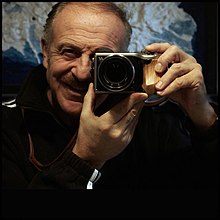This article has multiple issues. Please help improve it or discuss these issues on the talk page . (Learn how and when to remove these messages) |
Augusto De Luca | |
|---|---|
 Augusto De Luca in 2015 | |
| Born | July 1, 1955 |
| Nationality | Italian |
| Known for | photography |
| Awards | Città di Roma prize, 1996 |
Augusto De Luca (Naples, 1 July 1955) [1] is an Italian photographer specialized in portraits.
His first solo show was at Centro Teatro Spazio Libero, a theater founded in 1972 by puppeteer Renato Barbieri at Parco Margherita in Naples. [2]
In 1996, he was awarded the "città di Roma" prize for the photographs in the book Roma Nostra . [3]